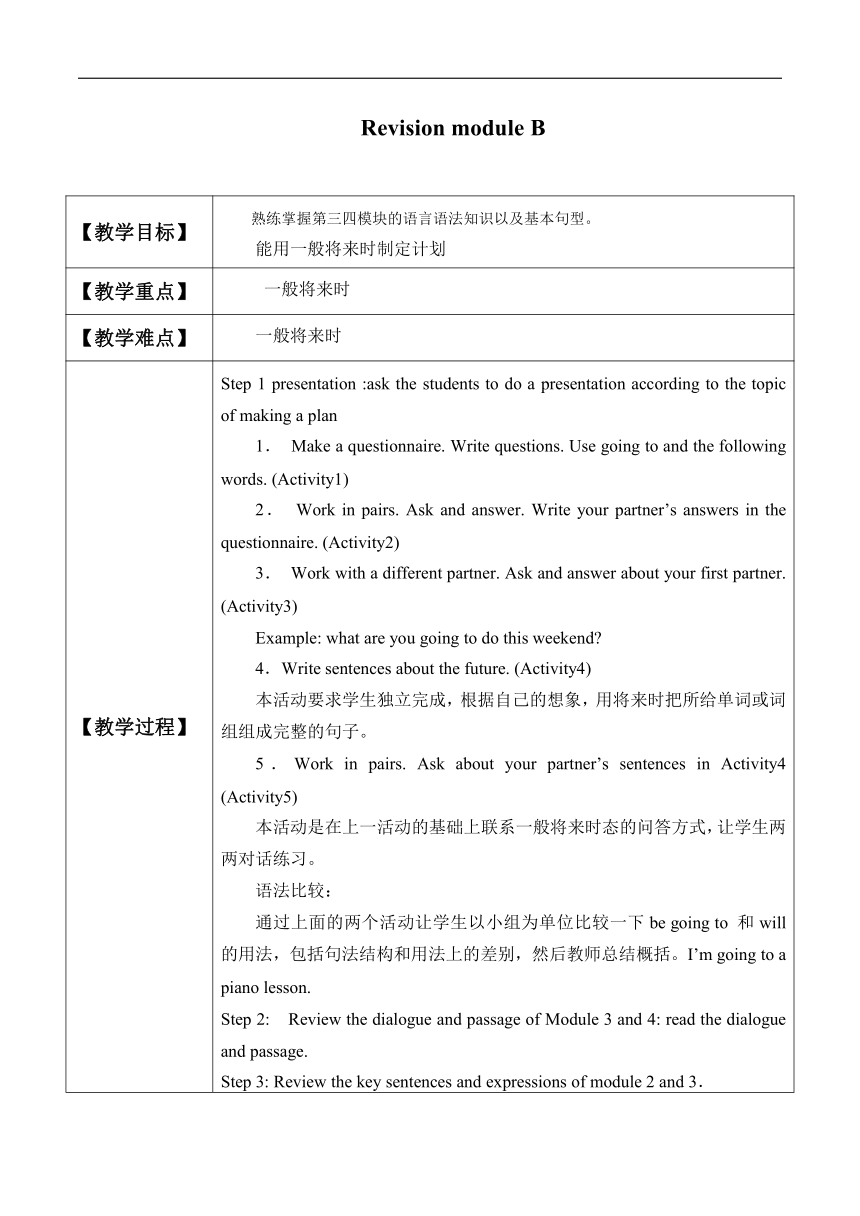外研版英语七年级上册 Revision module B 教案(表格式)
文档属性
| 名称 | 外研版英语七年级上册 Revision module B 教案(表格式) |

|
|
| 格式 | doc | ||
| 文件大小 | 26.9KB | ||
| 资源类型 | 教案 | ||
| 版本资源 | 外研版 | ||
| 科目 | 英语 | ||
| 更新时间 | 2021-08-25 10:34:39 | ||
图片预览

文档简介
Revision
module
B
【教学目标】
熟练掌握第三四模块的语言语法知识以及基本句型。
能用一般将来时制定计划
【教学重点】
一般将来时
【教学难点】
一般将来时
【教学过程】
Step
1
presentation
:ask
the
students
to
do
a
presentation
according
to
the
topic
of
making
a
plan
1.
Make
a
questionnaire.
Write
questions.
Use
going
to
and
the
following
words.
(Activity1)
2.
Work
in
pairs.
Ask
and
answer.
Write
your
partner’s
answers
in
the
questionnaire.
(Activity2)
3.
Work
with
a
different
partner.
Ask
and
answer
about
your
first
partner.
(Activity3)
Example:
what
are
you
going
to
do
this
weekend?
4.Write
sentences
about
the
future.
(Activity4)
本活动要求学生独立完成,根据自己的想象,用将来时把所给单词或词组组成完整的句子。
5.Work
in
pairs.
Ask
about
your
partner’s
sentences
in
Activity4
(Activity5)
本活动是在上一活动的基础上联系一般将来时态的问答方式,让学生两两对话练习。
语法比较:
通过上面的两个活动让学生以小组为单位比较一下be
going
to
和will
的用法,包括句法结构和用法上的差别,然后教师总结概括。I’m
going
to
a
piano
lesson.
Step
2:
Review
the
dialogue
and
passage
of
Module
3
and
4:
read
the
dialogue
and
passage.
Step
3:
Review
the
key
sentences
and
expressions
of
module
2
and
3.
Step
4:
review
the
learnt
grammar
一般将来时:be
going
to
一般将来时:will
Step
5:
do
some
exercises
on
PPT,
finish
individually
then
discuss
in
groups
Step
6:
make
a
conclusion.
【板书设计】
Revision
module
A
be(
am/
is/
are)
going
to
计划打算去做……
will
do
sth
【教学反思】
该单元核心教学项目是
“找寻物主”(Asking
about
ownership
),
这就不免牵扯到物主代词(Possessive
pronouns)的使用,但要让学生正确区分两种物主代词(形容词性的物主代词、名词性的物主代词),并不能仅仅从有没有“s”来做为标准,当然可以让学生找到其中小小的规律,即形容词性物主代词(my)
+名词(name)?
=名词性物主代词(mine)。另外,whose一词也可同法教学,它本身可以说是集形容词性和名词性于一身的一个词:Whose
clothes
are
these?
=Whose
are
these
(clothes)?
类似的还有名词的所属格也具备这一特征:Lucy
hat
looks
like
her
cat.
=Lucy
looks
like
her
cat.本单元是功能(Asking
about
ownership)、话题(Clothes)和语法项目(Possessive
pronouns)的典型结合。
module
B
【教学目标】
熟练掌握第三四模块的语言语法知识以及基本句型。
能用一般将来时制定计划
【教学重点】
一般将来时
【教学难点】
一般将来时
【教学过程】
Step
1
presentation
:ask
the
students
to
do
a
presentation
according
to
the
topic
of
making
a
plan
1.
Make
a
questionnaire.
Write
questions.
Use
going
to
and
the
following
words.
(Activity1)
2.
Work
in
pairs.
Ask
and
answer.
Write
your
partner’s
answers
in
the
questionnaire.
(Activity2)
3.
Work
with
a
different
partner.
Ask
and
answer
about
your
first
partner.
(Activity3)
Example:
what
are
you
going
to
do
this
weekend?
4.Write
sentences
about
the
future.
(Activity4)
本活动要求学生独立完成,根据自己的想象,用将来时把所给单词或词组组成完整的句子。
5.Work
in
pairs.
Ask
about
your
partner’s
sentences
in
Activity4
(Activity5)
本活动是在上一活动的基础上联系一般将来时态的问答方式,让学生两两对话练习。
语法比较:
通过上面的两个活动让学生以小组为单位比较一下be
going
to
和will
的用法,包括句法结构和用法上的差别,然后教师总结概括。I’m
going
to
a
piano
lesson.
Step
2:
Review
the
dialogue
and
passage
of
Module
3
and
4:
read
the
dialogue
and
passage.
Step
3:
Review
the
key
sentences
and
expressions
of
module
2
and
3.
Step
4:
review
the
learnt
grammar
一般将来时:be
going
to
一般将来时:will
Step
5:
do
some
exercises
on
PPT,
finish
individually
then
discuss
in
groups
Step
6:
make
a
conclusion.
【板书设计】
Revision
module
A
be(
am/
is/
are)
going
to
计划打算去做……
will
do
sth
【教学反思】
该单元核心教学项目是
“找寻物主”(Asking
about
ownership
),
这就不免牵扯到物主代词(Possessive
pronouns)的使用,但要让学生正确区分两种物主代词(形容词性的物主代词、名词性的物主代词),并不能仅仅从有没有“s”来做为标准,当然可以让学生找到其中小小的规律,即形容词性物主代词(my)
+名词(name)?
=名词性物主代词(mine)。另外,whose一词也可同法教学,它本身可以说是集形容词性和名词性于一身的一个词:Whose
clothes
are
these?
=Whose
are
these
(clothes)?
类似的还有名词的所属格也具备这一特征:Lucy
hat
looks
like
her
cat.
=Lucy
looks
like
her
cat.本单元是功能(Asking
about
ownership)、话题(Clothes)和语法项目(Possessive
pronouns)的典型结合。
同课章节目录
- Starte
- Module 1 My teacher and my friends
- Module 2 My English lesson
- Module 3 My English book
- Module 4 My everyday life
- Module 1 My classmates
- Unit 1 Nice to meet you.
- Unit 2 I'm Wang Lingling and I'm thirteen years ol
- Unit 3 Language in use.
- Module 2 My family
- Unit 1 Is this your mum?
- Unit 2 These are my parents.
- Unit 3 Language in use.
- Module 3 My school
- Unit 1 There are thirty students in my class.
- Unit 2 The library is on the left of the playgroun
- Unit 3 Language in use.
- Module 4 Healthy food
- Unit 1 We've got lots of apples.
- Unit 2 Is your food and drink healthy?
- Unit 3 Language in use.
- Module 5 My school day
- Unit 1 I love history.
- Unit 2 We start work at nine o'clock.
- Unit 3 Language in use.
- Revision module A
- Module 6 A trip to the zoo
- Unit 1 Does it eat meat?
- Unit 2 The tiger lives in Asia.
- Unit 3 Language in use.
- Module 7 Computers
- Unit 1 How do I write my homework on the computer?
- Unit 2 When do you use a computer?
- Unit 3 Language in use.
- Module 8 Choosing presents
- Unit 1 I always like birthday parties.
- Unit 2 She often goes to concerts.
- Unit 3 Language in use.
- Module 9 People and places
- Unit 1 We're enjoying the school trip a lot.
- Unit 2 They're waiting for buses or trains.
- Unit 3 Language in use.
- Module 10 Spring Festival
- Unit 1 Are you getting ready for Spring Festival?
- Unit 2 My mother's cleaning our houses and sweepin
- Unit 3 Language in use.
- Revision module B
